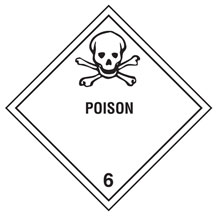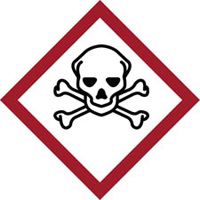



Find all of your laboratory and workplace safety supplies at Safety Emporium!
 Cutaneous |
 Glossary Index |
 Cyanosis |
| MSDS Topics |
Free Sites | FAQ's | Regulations | Glossary | Software | Suppliers |
| Books | Forum | Poll | Fun stuff | Quiz | Store | |
| Understand your MSDS with the MS-Demystifier | Search ALL our MSDS info | |||||

Be sure you're in compliance with DOT placards and labels from Safety Emporium.
A cyanide is a chemical compound that contains a cyano functional group, CN-. A chemist would say that the cyanide ion has a single negative charge and consists of a carbon atom that is triply bonded to a nitrogen atom, -C≡N:.
Cyanide is often used a shorthand term for hydrogen cyanide, HCN, also called hydrocyanic acid, a highly toxic gas and the simplest example of a cyanide compound.
Nitriles are organic compounds that contain a cyanide unit. These have the generic chemical formula RCN (where R = an organic group) and are sometimes referred to as organic cyanides.
Isonitriles, isocyanates, and isocyanides all have CN subunits in them, but are not considered cyanides because of the way that they bond to other atoms and their correspondingly different chemical reactivity.
The free cyanide anion, CN-, in
Exposure to 300 ppm of hydrogen cyanide by inhalation can be fatal within minutes and lower doses can endanger life. The high toxicity of HCN was once exploited for the execution of prisoners in several US states; the HCN was generated as needed by dropping NaCN (sodium cyanide) into a solution of sulfuric acid. See the last link under Additional Reading (below) for more information.

Bring it all together with laboratory lattice frames and connectors from Safety Emporium.
Ingestion of 100 to 250 milligrams of NaCN or KCN (potassium cyanide) can also be fatal as can absorption thorough injured skin. Solutions of sodium or potassium cyanide are extremely basic; the pH of a 0.1 M solution is approximately 11, meaning that it is quite corrosive.
At low doses, your body can cope with minute amounts of cyanide (it occurs naturally in certain foods, albeit in small amounts), but a "large" sudden dose (acute exposure) poses a serious medical emergency. Antidotes for cyanide poisoning include amyl nitrate, sodium nitrite, and intravenous sodium thiosulfate. These can be quite effective if administered promptly by a trained medical professional.
Cyanides which exist as simple salts (i.e they dissolve in water to form cyanide ions) usually contain the word "cyanide" as the last word in their name; for example, sodium cyanide (NaCN). When the CN- group is part of a nitrile molecule, the name will generally contain the prefix cyano- or the suffixes -nitrile, -onitrile or carbonitrile. Nitriles are usually less toxic than cyanide salts, although they may contain some of the latter as impurities. Aliphatic nitriles can be metabolized to the free cyanide ion, making them generally more toxic than arylnitriles which are stable in the body.
The cyanide unit occurs in other compounds such as cyanamide (carbodiimide, H2NC≡N), cyanoacetic acid (malonic mononitrile, N≡CH2COOH), potassium ferricyanide (K3[Fe(CN)6]) and potassium ferrocyanide (K4[Fe(CN)6]), however these compounds do not release cyanide and are therefore much less toxic than simple cyanide salts or many nitriles.

Your employees can stay informed and safety-ready with right to know stations and labels from Safety Emporium.
Cyanide salts and hydrogen cyanide are widely in industry. For example, through a process called hydrocyanation, HCN reacts with 1,4-butadiene (an alkene) to form adiponitrile (1,4-dicyanobutane, hexanedinitrile, tetramethylene cyanide, NC(CH2)4CN), a chemical precursor to hexamethylene diamine (1,6-diaminohexane, H2N(CH2)6NH2), which is one of the polymers used to make nylon.
A major use of cyanide salts is in gold mining. Crushed ore is sprayed with an aqueous solution of sodium cyanide, NaCN. The cyanide ion has a very high affinity for gold (Au) atoms and reacts to form the stable and soluble Au(CN)2- anion:
4 Au(s) + 8 CN-(aq) + O2(g) + 2 H2O(l)  4 Au(CN)2-(aq) + 4 OH-(aq)
4 Au(CN)2-(aq) + 4 OH-(aq)
The gold-containing solution is easily separated from the insoluble ore and recovered as solid gold (along with other valuable metals...as well as some toxic heavy metals) by reducing the dissolved metal complexes with zinc powder:
2 Au(CN)2-(aq) + Zn(s)  Zn(CN)42-(aq) + 2 Au(s)
Zn(CN)42-(aq) + 2 Au(s)
This process is done commercially on a millions of tons scale and is a major source of water pollution. There have been multiple cases where millions of gallons of cyanide-contaminated water have breached containment dams and poisoned wide areas.
Cyanides usually appear on a Safety Data Sheet in the context of incompatible materials. In general, cyanides are incompatible with acids, including even weak acids such as carboxylic acids and carbon dioxide, forming highly toxic HCN gas on contact. Cyanide salts are also generally incompatible with alkaloids, chloral hydrate, iodine, metallic salts, permanganates, chlorates and peroxides.
HCN is also produced when nitrogen-containing chemicals are burned. Therefore, the SDS may warn about HCN as well as carbon monoxide as toxic byproducts of combustion.
Hydrogen cyanide gas (HCN) has a characteristic odor of almonds, although not all people are able to detect this odor. Facilities utilizing HCN or with the potential to accidentally produce HCN should not rely on odor alone to warn of dangerous levels. The first link under Further Reading (below) has a detailed summary of precautions that industrial facilities should utilize if they handle HCN or cyanide salts.
Any work involving HCN or cyanide salts should only be conducted with rigorous training, written procedures, proper engineering controls, predefined emergency procedures, an evacuation plan, and first aid training.

Get your GHS-compliant labels and signs from Safety Emporium.
See also: amine, carboxylic acid, cyanosis, nitrile, volatility.
Additional definitions from Google and OneLook.
Entry last updated: Saturday, July 9, 2022. This page is copyright 2000-2025 by ILPI. Unauthorized duplication or posting on other web sites is expressly prohibited. Send suggestions, comments, and new entry desires (include the URL if applicable) to us by email.
Disclaimer: The information contained herein is believed to be true and accurate, however ILPI makes no guarantees concerning the veracity of any statement. Use of any information on this page is at the reader's own risk. ILPI strongly encourages the reader to consult the appropriate local, state and federal agencies concerning the matters discussed herein.